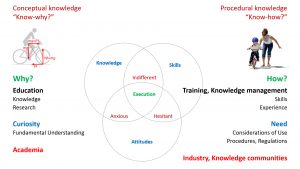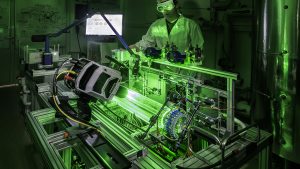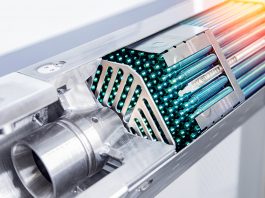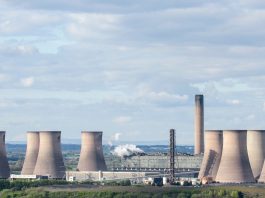Nuclear energy technologies have vast potential that society has hesitated to embrace fully.
In well-established, rigorously regulated, and heavily procedural industries, such as nuclear power technologies, there’s often a practical emphasis on procedural knowledge (know-how) over theoretical understanding (‘know-why’). While this approach might enhance the consistency and predictability of daily operations, it could sideline talent development within research-oriented higher education. This can heighten the risks associated with managing unforeseen challenges, diminish the drive for innovation, and weaken the academic nuclei of nuclear expertise beyond industry confines and regulatory bodies. Over time, this could erode public trust.
We believe that a balanced integration of both know-why and know-how can yield the best outcomes in attracting and nurturing new nuclear talents, all the while mitigating risks associated with routine operations and public perception. Such a balanced approach may be the key to the success of the wave of new builds projected by the European Nuclear Alliance, aiming at 150GW of nuclear electricity in the EU in 2050. This will also trigger more than 250,000 new nuclear talents.
Nuclear seasons
Nuclear power technologies hold significant promise in guiding a seamless shift towards a carbon-neutral society that values material and energy efficiency. For over 67 years, they have reliably delivered affordable, clean, and safe electricity. However, despite their commendable service and immense potential, society has gradually sidelined them in recent decades, particularly in developed nations with easy access to abundant (primarily carbon-rich) energy sources.
Prof Bum-Jin Chung1 of Kyung Hee University in Korea proposed a vivid explanation of what happened through a ‘four-season model’. In Europe and North America, the ‘nuclear spring’ (until about 1960) blossomed through strong and enthusiastic research and development activities. ‘Nuclear summer’ (1960-1980) followed with fast and successful industrialisation and commercialisation. ‘Autumn’ started in the early 1980s with a significant slowdown in new builds, research, and nuclear higher education. The stagnation in nuclear research and education activities then further developed in the ‘winter’ (1990 and later).2 Indeed, a recent EU R&D scoreboard,3 monitoring industrial R&D in high-tech industries, notes rather modest R&D investments in the energy sector and does not mention nuclear energy. In other words, the industrial R&D investments in nuclear energy technologies appear to be below the resolution of the official statistics. Luckily, as observed by Prof Chung, different places on the planet experience different seasons at different times. Chinese nuclear power, for example, is now somewhere between the late spring and early summer.
Indeed, the relationship between industry and academia is widely considered to be the key obstacle in producing and using new knowledge. This is, at least in part, a consequence of different forms of knowledge being of different utility for the industry and academia (conceptual, e.g. why? and procedural, e.g. how?). In propulsive ‘high-tech’ industries, the attraction and development of new talents are in significant part carried out through an academic research-based higher education system. Successful co-operation in developing new knowledge then results in the successful attraction and development of new talents and, in parallel, the strong flow of new knowledge towards practical and commercial application.
A strong connection between the research activities in academia and the attraction and development of new talents might appear intuitively obvious. However, strong partnerships are not easy to develop and maintain. As Evans4 has put it, “industry partnerships draw high-status academics away from confirming theories and toward speculation.” Further challenges in maintaining such partnerships may occur over longer periods of time. A nuclear power plant can last for a century, therefore, such a time-span calls for the explicit involvement of societal decision-makers with a long-term vision.
Competencies for today’s nuclear
Competent people are at the core of successfully utilising high technologies, including nuclear power. IAEA5 defines competence as applying skills, knowledge, and attitudes to perform an activity or a job to a specified level effectively and efficiently. Competences may be developed through education, experience, and formal vocational training.
The crucial distinctions between education and training are well-known and well-discussed in the literature. Highley offered an interesting and clear perspective,6 noting that individuals trained in health physics can safely manage daily operations under routine conditions. However, academically educated individuals are much more successful in dealing with many unexpected events. Similar observations are reported by Cheung,7 who also relates different forms of knowledge, in particular conceptual (knowing why) and procedural knowledge (knowing how) with academic education, vocational training and the ability of trainees to generalise the procedural knowledge towards the solution of challenges, that differ from those mastered during the training.

A graphical summary of the knowledge, skills, and attitudes is offered in Fig. 1.
Nuclear power technology industries depend on competent people with very diverse degrees and specialities of education and training. The quest for efficiency, stimulated partly by decades of declining nuclear education2 and by the pressures of competition and evolving regulations, might steer the industry towards more internal training. This is naturally directed more towards know-how than ‘know-why’. An important driver towards such developments may also be the fact that these industries strongly rely on know-how, documented in considerable detail in operating procedures and regulations.
As noted vividly by Sanchez-Alarcos in his 2020 book Aviation and Human Factors: How to Incorporate Human Factors into the Field: “In some ways, the safest way to avoid human manual error is to handcuff the operator, but at the same time, that operator will be unable to solve the problem when required. Handcuffs can be physical, such as programming the plane to disobey the pilot because someone decided that the plane’s sensors would know better, or cognitive, providing operating know-how instead of know-why.”
In the short term, the prevalence of the know-how approach may appear to increase the industry efficiency and safety record. In the medium and longer term, however, the prevalence of the know-how acquired in mostly proprietary in-house training may contribute to some important risks, which might develop gradually and intensify with time as a surprise to the community. These potential risks include:
- Reduced ability to manage unexpected situations: ‘unknown-unknowns’;
- Reduced potential and/or need for innovation. This is usually followed by the loss of competitiveness, especially against other competing technologies, and the loss of interest of young creative talents. This suggestion is supported by the fact that the R&D investments of nuclear industry are not reported among the energy industry investments;3 and
- Perception of high expertise and low credibility of the nuclear industry in the public. Preferential internal and proprietary training could further disable the interest for and performance of the nonproprietary nuclear higher education as collateral damage. After a decade of such developments, one might notice an absence of nuclear expertise outside of the industry and the regulator, which may seriously degrade the public perceptions of the safety, reliability, and credibility of all nuclear facilities. Further, this may also degrade the competence in organisational levels outside of the nuclear industry, such as regulatory bodies, technical support organisations, and the public, including academia.
Competences for future nuclear energy technologies
Successful development of new nuclear talent requires suitable sequences and a balance of ‘know-why’ and know-how. In other words, deliver the conceptual knowledge in dedicated academic education before the professional training towards mastering the procedural knowledge related to specific nuclear energy technology. Vivid and well-known illustrations of this principle include “We were trading the rules for common sense” (Semler, R, 2001. Maverick: The Success Story Behind the World’s Most Unusual Workplace, Random House), and “If we have our own why in life, we shall get along with almost any how.” (Nietzsche, F W, Large, D, 1998. Twilight of the Idols: or How to Philosophize with a Hammer, Oxford University Press).

A well-designed and well-balanced combination of academic education (‘know-why’) and industrial training (know-how) is therefore considered as one of the essential building blocks of any future nuclear talent attraction and development scheme. Such well-balanced approaches require robust and durable co-operation between the academy, industry, and governments. With industry mostly in need of research towards immediate application, and academia being proud of its curiosity driven basic research, the middle ground might be a sensible combination of both.
Indeed, our recent analysis8 of the contributions towards basic or applied research by 51 PhD theses in nuclear engineering developed in Slovenia since 1993 suggests a reasonable combination of both basic and applied contributions. We may therefore infer that the current nuclear academic education system is reasonably well conceived and could be further improved through more intensive research interactions with the industry and regulatory agencies. Long-term and interactive relationships involving third parties from international academia, industry and regulatory community, appear to be ideal for developing mutual trust and successful co-operation in an inherently unpredictable research environment.
Assuming that attitudes are formed through experiences in education, training and professional life, well balanced education and training in nuclear energy technologies may also naturally result in well balanced attitudes. Experiences of progressing through trial and error in the academic research might also be useful in the error-preventing procedural safety culture environments. If it is true that ‘to err is human,’ then errors will naturally also occur in the error-preventing environments. An experience in error detection and management could therefore actually enhance the attitudes towards safety culture.
A glimpse into a lab
Investments in new research infrastructures will have a crucial role in the future development of new nuclear talents. A recent addition is the Thermal-Hydraulics Experimental Laboratory for Multiphase Applications (THELMA, Fig. 2), launched at the Jožef Stefan Institute in 2019. It aims at accurate measurements of the convective single- and two-phase heat transfer, including boiling. Several high-speed cameras are available in visual and infrared light spectra and facilitate observation of high-speed phenomena, including turbulent flows, convective heat transfer, bubble dynamics, and their interactions. A synchronised system of pulsed laser and multiple high-speed cameras enable measurements of planar and volumetric velocity fields using the particle image velocimetry (PIV) method.
The main ability of THELMA allows for visual observations of various boiling regimes, including temperature-controlled conditions close or at the critical heat flux, where the boiling abruptly ceases to be an effective heat transfer mechanism. In this way, the conditions at critical heat flux can be investigated without the danger of overheating the experimental equipment.
A glimpse into the future of nuclear power technologies
Substantial investments in nuclear research infrastructures will be needed to meet the expected large demand for new talents and to support the development of promising new nuclear power technologies, including small, modular, and advanced reactors. This will also include new research reactors. The Jožef Stefan Institute has been operating a TRIGA Mark II reactor since 1966 and is preparing to propose the construction of a new one at the institute’s premises in the near future.
References
- Chung, B-J, 2006. Perspective of international activities on nuclear knowledge management and proposals for further refinements. International Journal of Nuclear Knowledge Management 2, 105-113
- OECD/NEA, 2000. Nuclear education and training: cause for concern? https://www.oecd-nea.org/upload/docs/application/pdf/2019-12/nea2428-education.pdf
- The 2022 EU industrial R&D investment scoreboard https://iri.jrc.
ec.europa.eu/scoreboard/2022-eu-industrial-rd-investment-scoreboard - Evans, James A, 2010. Industry Induces Academic Science to Know Less about More. The American Journal of Sociology 116, 389-452
- IAEA, 2022. Recruitment, Qualification and Training of Personnel for Nuclear Power Plants, SSG-75. https://www.iaea.org/publications/14906/recruitment-qualification-and-training-of-personnel-for-nuclear-power-plants
- Higley, K A, 2017. Education vs. Training: Does it Matter? Health Physics 112, 165-171
- Cheung, J J H, 2021. Knowing How and Knowing Why: Integrating Conceptual Knowledge in Simulation-based Procedural Skills Training to Support Learning Transfer, Dissertation, Institute of Medical Science. University of Toronto ON, Canada
- Cizelj, et al, Know-why and know-how in the development of nuclear talents: an analysis of recent nuclear engineering PhD research, Nucl Eng Des 2023 in print
Please note, this article will also appear in the sixteenth edition of our quarterly publication.









